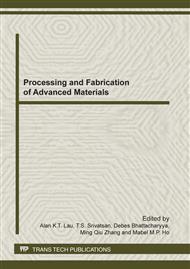p.22
p.23
p.24
p.25
p.26
p.31
p.32
p.36
p.39
Electrospun Nanofibre Cores Containing Graphene Oxide for Sandwich Films: Manufacturing and Analysis
Abstract:
The motivation for the need of small-scale devices has made thin films technologically important in the recent years. They have found applications in broad fields, such as microelectronic integrated circuits, magnetic information storage systems, optical coatings and wear resistant coatings. However, the mechanical performance of these materials tends to depend on fabrication and post-processing parameters. With the intent of improving the mechanical properties of the films, a relatively novel concept of sandwich composite films has been tried in this research. Poly-methyl methacrylate (PMMA) and Graphene Oxide (GO) have been used to manufacture the sandwich films, where PMMA films have served as the facings and electrospun PMMA/GO nanofibre mat forms the sandwich core. Dimethylformamide (DMF) and Tetrahydrofuran (THF) solvents are used in suitable proportions to dissolve PMMA, and then GO is added to this solution to obtain a uniform suspension of PMMA/GO for electrospinning. The mechanical and functional properties depend on the fibre quality and their distributions in the mat, which in turn depends on the concentration of the solution. Therefore, design of experiments based on mixture analysis was used to identify the solution concentration for obtaining uniform fibre diameters and their distribution throughout the electrospun core. The analysis suggested 23% PMMA and 2% GO concentrations in the solution would give uniform fibre diameters and dispersion throughout the mat.
Info:
Periodical:
Pages:
26-30
Citation:
Online since:
November 2011
Authors:
Keywords:
Price:
Сopyright:
© 2012 Trans Tech Publications Ltd. All Rights Reserved
Share:
Citation:



